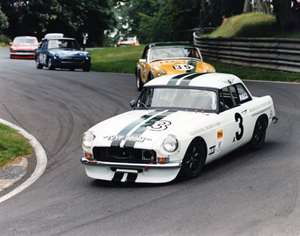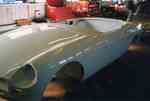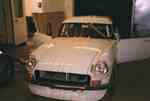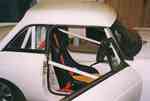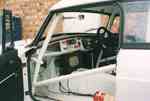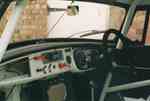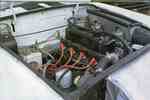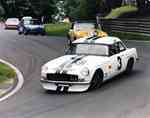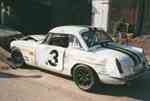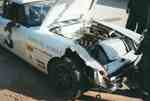Having watched Formula 1 all my life and come to the realisation that I would never have enough money or skill to compete, all my boyhood dreams disappeared. On founding Maidstone Sports Cars in 1987 all my energy, time and money was concentrated on making a go of my business. I also became aware that I had more of an interest in building rather than racing cars. It was only after attending a British Sports Car Racing Day at Brands Hatch in 1999 that I began to think, "We could do that". Yes, build and race our own car!
My early worries about Motorsport being a bottomless money pit were pushed to the back of my mind and I started to think out plans for the future. We were fortunate to have an old but suitable MGB rolling shell, which had new sills and floor etc. had been shot blasted and the underside painted white. It had stood forlorn in all weathers for years and looked in a very sorry state. There was no way we were ever going to get this vehicle back on the road, even though it had had much panel work carried out. The panel fit was just not good enough to come up to our exacting standards and it was deemed uneconomic to carry out the rectification work. But it would make a great race car, where door fits aren't quite so important. So first things first. Choose your championship-The race series you wish to take part in, so that you can get the relevant regulations, study them and build your car according to those regulations. There is little point in building a car which does not conform and is therefore not eligible to race.
The choice for MG racing is vast with the MGOC and MGCC running a variety of championships catering for all models and we eventually settled for the BCV8 championship as this is one of the oldest and most competitive series. So now to work! Holes were drilled in the floor to drain out the water and the car went into one of our panel shops, up on stands and a complete assessment was made. The underside looked good from the previous work undertaken and was a good help. The bodyshell needed work with many areas being seam welded over the spot welds to give added strength. A Lightening process then took place. All unnecessary bracketry was removed. Holes were drilled in hinges to remove excess metal, doors, centre console etc. all lightened. The boot lid cross brace was removed. It all looks pretty insignificant until you gather all the bits together and weigh them.
It was at this time that the heater box, LHD pedal holes etc. were blanked off using aluminium. The next stage was to fit a Safety Devices roll cage including door bars which were welded in for extra strength. We also fabricated extra points to join the roll bar to the link bar which is under the dashboard. All the weight we had tried to lose seemed to have been made up by the roll cage. A pair of fibreglass wings and special tuning spoiler was fitted along with an aluminium bonnet. The rear wheel arch lips were bent upwards to increase wheel arch space and remove any sharp areas. The holes behind the doors in the 'B' posts were welded up so as to enclose the whole boot area. This was seen as a safety measure in the event of fire.
With the bodyshell complete the whole vehicle was painted in two pack Glacier White including the roll cage. The shell was looking great so we moved on to the suspension system. Of course we were guided by the regulations for the Standard class MGB. We already had a crossmember which had been shot blasted and painted. To this we fitted a set of negative camber wishbones, 6601bs lowered springs and uprated shock absorbers all fitted together using polyurethane bushes. We reconditioned one of our steering racks and refitted the whole assembly on mass with an uprated anti-roll bar. The front brakes were restricted to standard sizes apart from braided front flexible and uprated pad material. For the rear we had to locate a good early Banjo axle which is substantially lighter than the later Salisbury axle. This was duly stripped, rebuilt and painted. Again we used uprated and lowered rear springs using polyurethane bushes throughout. Uprated lever arms were installed.
For the rear brakes we used a mixture of uprated linings and Metro wheel cylinders to help the brake bias and stop rear wheels locking up first. (A common problem, even on road cars). We decided to run fuel lines, brake lines, wiring and power lines through the vehicle interior. These were fitted, separated and 'Clipped into position. When deciding to build this car Safety had been paramount in our minds. A good quality Corbeau Pro-Race seat and frame were purchased and fitted along with a TRS four point harness. A 2.5 CT Lifeline fire extinguisher was plumbed in giving that extra bit of security.
We created a problem for ourselves when we fitted the roll cage to the dash cross strut. The rules state that a standard dashboard must be fitted but with our extra roll cage connections this was not possible. The only way to fit it was to cut it in half by the glove box and fit it in two pieces. Painted white it really looks good. We plumbed hi the standard wiring loom though, again to comply with the regulations. This car must remain road legal and fully M.O.T'd. Even so we disposed of the ignition key, fitted a simple on/off switch and a starter button. The battery cut-off was positioned in the dash within easy reach of the driver and if course connected to the exterior pulls.
After years of experience with the standard MGB Rev counter waving about and giving wild readings, it was decided to replace it with a modern accurate unit and in view of who was going to drive it, (more on that later), we also fitted a Rev limiter and change up light. All pretty simple to wire in and hopefully stop an engine blow up. With the rolling chassis almost complete our attention turned to the power train.
After studying the regulations once again it became clear that one is very restricted to what you can do. A chance phone call led to the lucky purchase of an engine from a previous championship wining car. This engine was stripped down and fully rebuilt replacing all bearings, piston rings, timing chain, oil pump etc.
We lightened a set of Series A cam followers and carefully built up the unit fitting a new uprated balanced clutch with a Roller bearing release unit. A performance distributor was purchased and fitted with a Luminition performance electronic ignition system. No head work was allowed but the camshaft for lightness and reliability we chose to use a MGB 4 synchro mesh non overdrive gearbox. This was duly stripped and rebuilt to standard spec, and the engine gearbox unit installed in the vehicle. An uprated starter motor which is very light and powerful was fitted on the standard mounts. With its new found weight in the car it now looked like a drag racer and spacers had to be inserted in the front suspension to get the car sitting right at the correct level of ride height. A Minimum of five inches ground clearance.
From our distant past we found a black framed windscreen frame which we assembled with new glass and rubbers. A pair of old quarter lights were cleaned up and the frames painted black to match the screen. When fitted these looked good. Headlights and sidelights were wired in and a central rear fog light, obligatory under the racing regulations. Front and rear bumper blades with standard fittings were used along with a recessed grill. This was chosen in preference to the slatted grill type as it was felt that this would be more efficient at funnelling air into the engine bay. The radiator was fully cowled in and the oil cooler moved underneath the radiator platform all to aid cooling. An air pipe was fabricated to feed air to the carburettors which again had to remain standard 1.5 inch SLTs.
We fabricated an alloy oil catchment tank which we placed behind the carburettors. This had a breather from the rocker cover and from the engine side cover. A standard fuel tank was fitted but the filler cap is a screw aero flush cap inside the boot along with a Facet fuel pump. The pressure regulator was placed in the engine bay and had to have an alloy filter bow LAU fuel line are copper with braided flexible. With the Corbeau race seat fitted and the roll cage with side bars in place, entry and exit from the car was difficult. To ease the situation we fitted a quick release steering wheel. This modification has certainly made accessibility easier. We used an OMP black suede wheel which feels good and should give the grip and comfort needed. As our car is running in the Standard class the entire interior trim panels nave to be fitted along with door handles, window winders etc.
Each car has to use a hard top. We were lucky to be given a very tatty works hardtop which we stripped and rebuilt. We had to cut out the inner headlining skin so that it would fit over our roll cage, but once in position it really finished off the car, but made access more difficult, we ended up lowering the seat so the driver's helmet would not be banging on the roof. Brake and clutch hydraulics were filled with high boiling point brake fluid and duly bled. For a good firm pedal NO Servo was fitted. The axle and gearbox were filled with fully synthetic gear oil which should offer ultimate protection with low resistance.
After much thought we also opted to use a fully synthetic engine oil. Minilite alloy wheels up to 5.5m are now allowed, so we fitted a set with the approved tyre combination of Dunlop D84 185/60 X 14. Tracking was checked and set up. We also corner weighted the car to get the optimum balance. Construction complete, now for the start up. Warm up the engine and set the ignition and carburettors on our four gas analyser.
A rolling road session was then needed to get the optimum setting, but with the tubular manifold, large bore exhaust and high lift cam, she certainly sounded the part. A quick run up the road was used to settle the suspension and test brakes. All seemed fine. At this point she was nicknamed "The Fridge" because she was a mass of Glacier White,(Fridge white). To comply with our company colour scheme two green stripes were applied over the centre of the vehicle and the wheels were also painted green. The car suddenly looked 20mph quicker. (If only). A rolling road session was booked and many necessary adjustments made. To make the best of the vehicle you have built, cannot emphasize enough, the importance of using a good rolling road and someone who really knows what he is doing. Our session, which took many hours, resulted in a 25% increase in power and the final figures impressed everyone including the rolling road operator.
Next stop the weighbridge just to make sure we were not underweight and still within the class regulations. The car was then M.O.T'd to comply with regulations. As this was a new car, track tune was imperative, but time was running out. We needed to scrub in the new tyres, bed in the brakes etc. and really get to know the handling and performance characteristics of the vehicle. A test day at Lydon circuit was duly booked and we all headed off to put the car through its paces. During the space of a single morning we managed to have a dry, a damp and a wet track so were able to assess the car's possibilities. As this was a team effort Adrian Hall M.S.C. bodywork guru was to be the driver as he had had previous racing experience in modified Ford Escorts. Everyone at work wanted to see if he was as good as he said he was!
Adrian certainly showed his skill and abilities in all conditions and silenced all the 'doubters'. It was then back to our workshop for an oil and filter change, final adjustments and a clean-up, because our first outing was at Cadwell Park the very next day. Talk about running things tight!!!! Our first race at Cadwell Park resulted in a Class win and a fastest lap. Not bad for starters. Through the season after many ups and downs including two major accidents, one at Snetterton and one at Oulton Park which both resulted in a major rebuild, our season ended on the ultimate high when at the last round at Cadwell we secured the Class A championship and the BCV8 Overall championship. We finished with ten class wins out of fourteen starts including seven fastest laps and numerous lap records. Not bad for our first venture into racing and congratulations to all the boys at MSC for their efforts.
I think our efforts have shown that you don't need vast budgets to compete and win. What a spectacular sight it is to see a grid full of MGs roaring away from the starting line. So even if you don't want to compete why not support the racers by "spectating"? Sure you will be surprised by just well the old MGB can be made to go.
With recent success for Maidstone Sports Cars prepared cars in the BCV8 challenge, the Monte Challenge and Le Jog.
